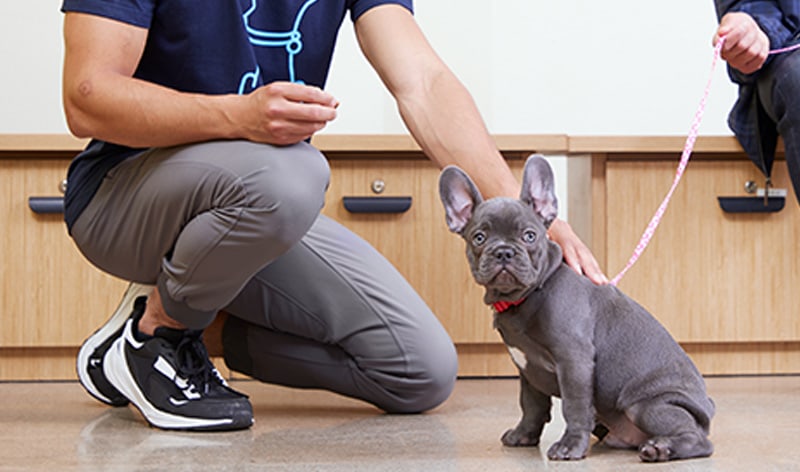Puppy Training Techniques: Teaching Basic Commands for a Happy Pet
Puppy Training Techniques: Teaching Basic Commands for a Happy Pet
Blog Article
Leading Pup Educating Techniques to Make Sure a Mannerly Animal
Efficient young puppy training is crucial for cultivating a well-behaved companion, and numerous strategies can dramatically affect a pet's growth. Amongst these, favorable reinforcement stands apart as a foundational approach, promoting count on and encouraging preferable habits. Consistency in commands and early socialization are similarly essential, laying the groundwork for a well-adjusted pet. In addition, the functions of cage training and chain decorum can not be ignored. As we explore these methods better, it ends up being clear that the success of young puppy training depends upon a mix of methods that can transform your pet dog's habits in amazing methods.
Positive Support Techniques
Using favorable reinforcement methods is vital for reliable puppy training, as it urges desired actions with incentives as opposed to penalty. This method takes advantage of the natural understanding processes of canines, enhancing etiquette by providing tangible and immediate benefits, such as deals with, appreciation, or play. By linking favorable outcomes with particular activities, pups are most likely to repeat those behaviors in the future.
Rewards need to be offered instantly after the desired actions happens to produce a clear connection in the pup's mind. In addition, varying the types of incentives can preserve a pup's interest and inspiration throughout the training procedure.

Consistency in Educating Commands
Keeping consistency in training commands is essential for strengthening the lessons discovered via positive support strategies. Dogs flourish on regular and predictability, so using the same verbal commands and hand signals for details actions is necessary. This harmony assists pups recognize what is expected of them, decreasing confusion and stress for both the animal and the fitness instructor.

Timing likewise plays a significant duty in uniformity. Commands must be supplied without delay throughout training sessions and complied with right away by positive reinforcement, such as treats or appreciation. This prompt feedback assists strengthen the organization between the command and the wanted actions.
Integrating uniformity into training sessions will develop a steady understanding environment, promoting quicker proficiency of commands. Eventually, a well-structured approach promotes a strong bond between the pup and its proprietor, leading to a much more well-behaved and obedient family pet.
Socialization With Various Other Pets
Socialization with various other pets is critical for a young puppy's development, as it aids them discover proper behaviors and communication skills in diverse social contexts. Very early communications with various animals can considerably affect a pup's character and flexibility in different circumstances. When pups are revealed to a variety of animals, they come to be more positive and much less scared, which click this can prevent possible behavior concerns later in life.

Moreover, observing body language throughout communications is crucial. Instruct your puppy to identify signals from various other animals, such as signs of playfulness or discomfort, cultivating common respect and understanding. Regular socializing not only enhances your young puppy's social skills however also adds to their general wellness, creating an extra unified living atmosphere. To conclude, prioritizing communications with other pets will certainly generate a all-around and socially adept canine.
Dog Crate Training Advantages
Identifying the various benefits of crate training can substantially boost both the pup's and owner's experience. Crate training gives a safe and safe and secure setting for puppies, ensuring they really feel protected when laid off. This complacency can substantially reduce stress and anxiety and stress levels for both the family pet and the proprietor.
Additionally, crates serve as a beneficial housebreaking tool. Young puppies normally prevent staining their resting area, thereby urging them to hold their bladder until they are let outside. This impulse can accelerate her latest blog the house-training procedure, cultivating excellent habits at an early stage.
Crate training likewise helps in taking care of a pup's actions when not being watched. By offering an assigned space, owners can prevent destructive actions, such as chewing on furniture or entering into dangerous materials. Crates can be valuable throughout traveling, supplying an acquainted area that can assist calm a pup in new environments.
Last but not least, developing a dog crate routine urges self-reliance, allowing pups to discover how to be alone without anxiety. Generally, dog crate training is an efficient method for advertising security, tranquility, and technique, causing a well-adjusted, well-behaved family pet.
Leash Training Basics
Leash training is a fundamental facet of accountable pet possession that makes sure a risk-free and delightful walking experience for both the pup and its owner. Appropriate chain training begins early, preferably during the pup's socialization duration. This training aids develop excellent routines and promotes positive habits when out in public.
To start, pick a comfy collar or harness that fits your puppy well. Connect a strong chain, ensuring it is not as well long, as this can cause drawing and erratic behavior. Begin in a peaceful setting to reduce diversions and slowly present your young puppy to brand-new surroundings.
Use positive reinforcement methods, such as deals with and appreciation, to urge your pup to stroll beside you. Stop walking and wait for them to return to your side before continuing if your puppy pulls. This shows them that pulling will not yield forward Check This Out movement. Consistency is essential; practice regularly and remain client, as mastery takes some time.
Additionally, incorporate short training sessions with fun diversions to develop your puppy's focus. With dedication and perseverance, chain training will result in a well-mannered companion, making strolls satisfying for both the owner and the pup.
Verdict
In final thought, using effective young puppy training techniques is important for creating a well-behaved family pet. On the whole, these methods jointly promote a harmonious partnership between pups and their owners.
As we check out these techniques further, it ends up being clear that the success of pup training hinges on a combination of approaches that can transform your animal's habits in remarkable means.
Using favorable support techniques is vital for reliable puppy training, as it motivates wanted behaviors via incentives rather than penalty.Crate training likewise aids in taking care of a pup's behavior when unsupervised.Leash training is an essential element of liable pet dog possession that makes certain a safe and enjoyable walking experience for both the young puppy and its owner.In final thought, employing effective young puppy training methods is important for establishing a well-behaved family pet.
Report this page